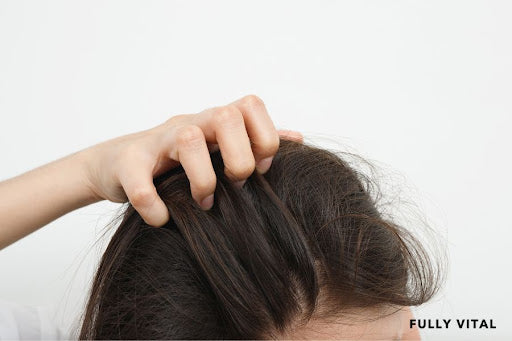
Tinea Amiantacea: Understanding And Preventing Hair Condition
As someone who has struggled with various hair conditions, I know how important it is to find effective solutions that promote hair growth.
One condition that often goes unnoticed but can have severe consequences is tinea amiantacea.
In this article, I will answer commonly asked questions about tinea amiantacea to help you understand it better and emphasize the significance of awareness and prevention.

I LOVE MY HAIR NOW
FullyVital hair serum and hair vitamins made tremendous improvements in my hair. I truly love my hair now.
Dorit S.,
What Is Tinea Amiantacea?
Tinea amiantacea is a scalp condition characterized by thick and adherent scale patches that bond to the hair shafts, mimicking a silver asbestos-like appearance.
It is often a manifestation of an underlying scalp disorder, particularly seborrheic dermatitis or scalp psoriasis.1
These conditions cause an excessive growth of skin cells, resulting in the formation of scales that clump around the hair strands.

Why Is Awareness Of Tinea Amiantacea Important?
Awareness of tinea amiantacea is crucial as it can lead to further complications if left untreated.
The scales can tightly bind the hair together, leading to extensive hair loss and potential damage to the hair follicles.
By identifying and addressing tinea amiantacea early on, you can prevent the progression of the condition and protect your hair from further damage.
How Does Tinea Amiantacea Work?
Tinea amiantacea is primarily a result of underlying scalp disorders.
When these disorders cause excessive skin cell growth, the dead skin cells accumulate on the scalp surface, forming scales.
These scales, combined with sebum and sweat, adhere to the hair shafts, leading to the characteristic asbestos-like appearance.
What Are The Benefits Of Preventing Tinea Amiantacea?
Preventing tinea amiantacea is essential for maintaining healthy hair growth.
By addressing the underlying scalp conditions that contribute to tinea amiantacea, you can minimize the formation of scales and prevent excessive hair loss.
Achieving a scalp in optimal condition allows your hair follicles to function properly, promoting natural and healthy hair growth.
Are There Downsides In Tinea Amiantacea Treatment?
While treating tinea amiantacea is crucial, it's important to be aware of potential downsides that can vary depending on the chosen treatment method.
Some downsides may include:
- Temporary dryness or sensitivity of the scalp due to medicated shampoos or topical treatments.
- Potential recurrence of tinea amiantacea if the underlying scalp disorder is not adequately managed.
- The need for consistent and long-term treatment to maintain scalp health.
It's essential to consult a dermatologist or trichologist to determine the most suitable treatment approach for your specific case.
What Are The Alternatives To Tinea Amiantacea?
When it comes to addressing tinea amiantacea and its underlying scalp conditions, several alternatives can be considered.
These alternatives may include:
- Using medicated shampoos containing antifungal agents or corticosteroids prescribed by a healthcare professional.
- Employing natural remedies like tea tree oil or apple cider vinegar as adjunct treatments.
- Incorporating regular scalp exfoliation to remove dead skin cells and promote a healthier scalp environment.
How Common Is Tinea Amiantacea Worldwide?
Tinea amiantacea is a condition that affects people globally, regardless of age, gender, or ethnicity.
Although there is limited data on its exact prevalence, it is known to be more common in regions with high humidity and warm climates.
In these environments, factors such as increased sweat production and fungal growth contribute to the occurrence of tinea amiantacea.2
What Are The Common Misconceptions About Tinea Amiantacea?
- Misconception: Tinea amiantacea is a rare condition.
- Fact: While tinea amiantacea may not be as well-known as other scalp conditions, it is relatively common and can cause significant hair-related issues if left untreated.
- Misconception: Tinea amiantacea is solely caused by poor hygiene.
- Fact: Tinea amiantacea is primarily a result of underlying scalp disorders like seborrheic dermatitis or scalp psoriasis. It is not exclusively linked to poor hygiene practices.
- Misconception: Tinea amiantacea is untreatable.
- Fact: With proper diagnosis and appropriate treatment, tinea amiantacea can be effectively managed and its impact on hair growth minimized.
What Are The Effects Of Tinea Amiantacea On Hair?
Tinea amiantacea can have various effects on hair, including:
Hair loss
The scales formed by tinea amiantacea can clump and bind the hair together, leading to the loss of hair strands.
Thinning and breakage
The tight adherence of scales to the hair shafts can make them brittle, resulting in increased hair breakage and thinning.
Impaired follicle function
The presence of tinea amiantacea can hinder the normal functioning of hair follicles, leading to a decrease in new hair growth.3
What Is The Psychological Impact Of Tinea Amiantacea?
Dealing with tinea amiantacea can have a significant psychological impact on individuals.
Some common effects include:
- Low self-esteem: Hair loss and changes in hair appearance can negatively affect one's self-confidence and self-image.
- Social anxiety: The visible signs of tinea amiantacea, such as silver-like scales, can lead to embarrassment and discomfort in social situations.
- Psychological distress: The emotional toll of dealing with a persistent scalp condition and its effects on hair can cause stress, anxiety, and frustration.
What Are The Lifestyle Adjustments For Patients With Tinea Amiantacea?
While it is crucial to follow the advice of healthcare professionals regarding treatment, incorporating lifestyle adjustments can help manage tinea amiantacea more effectively.
Consider the following:
Maintain scalp hygiene
Regular cleansing of the scalp using mild and medicated shampoos recommended by your dermatologist can help remove scales and maintain a healthy scalp environment.
Avoid harsh products
Steer clear of styling products, shampoos, or conditioners that can further irritate or dry out the scalp.
Opt for gentle and scalp-friendly alternatives.
Protect against excessive heat styling
Excessive heat from hair dryers, straighteners, or curling irons can worsen scalp conditions.
Use heat protectants and limit styling tool usage.
Manage stress levels
High stress levels can exacerbate scalp conditions.
Incorporate stress-reducing activities such as exercise, meditation, or engaging in hobbies to promote overall well-being.
Remember that maintaining a healthy lifestyle and seeking professional guidance can greatly contribute to managing tinea amiantacea effectively.
Make The Change Today, For Yourself And For Your Hair!Are you ready to embrace a renewed relationship with your hair? At Fully Vital, we're dedicated to empowering you with science-backed hair growth products that halt the aging process of your locks. Our mission is to redefine your hair's journey, giving you the confidence to flaunt vibrant, healthy hair. Experience the Benefits:
Elevate your hair care routine with Fully Vital's transformative hair growth products. Let us partner with you on your journey to vibrant, age-defying hair that radiates beauty and vitality. Your locks deserve nothing less than the best – embark on a path of transformation today! |
Final Thoughts On Tinea Amiantacea
Understanding tinea amiantacea and its impact on hair growth is essential for those seeking to maintain luscious and vibrant locks.
By exploring its prevalence, effects on hair, lifestyle adjustments, and addressing frequently asked questions, we have gained valuable insights into this scalp condition.
As a Hair growth product company, we recognize the significance of tinea amiantacea in our mission to provide effective solutions for healthy hair.
At Fully Vital, we offer a variety of hair growth products designed to halt the aging process of your hair and promote a more vibrant and vibrant relationship with your locks.
Whether you are dealing with tinea amiantacea or looking to enhance your hair's vitality, we are here to support you on your hair growth journey.
Remember to consult with a healthcare professional for personalized advice and treatment options.
Let's embrace scalp health and nourish our hair from root to tip.
Frequently Asked Questions On Tinea Amiantacea
How is tinea amiantacea diagnosed?
To diagnose tinea amiantacea, a dermatologist or trichologist will typically perform a thorough scalp examination.
They may also take a closer look at the characteristic silver-like scales and evaluate your medical history.
In some cases, a scalp biopsy or microscopic examination may be required to confirm the diagnosis and rule out other possible conditions.
Can tinea amiantacea lead to hair loss?
Yes, tinea amiantacea can lead to hair loss.
The scales formed by this condition can tightly bind hair strands together, leading to hair breakage and thinning.
If left untreated, the continued presence of tinea amiantacea can eventually damage hair follicles, resulting in more significant hair loss.
How common is tinea amiantacea?
While accurate prevalence data is limited, tinea amiantacea is considered a relatively uncommon scalp condition.
However, its occurrence can vary depending on factors such as geographical location, climate, and the prevalence of underlying scalp disorders like seborrheic dermatitis or scalp psoriasis.
Who is prone to get tinea amiantacea?
Tinea amiantacea can affect individuals of any age or gender.
However, those with underlying scalp conditions, compromised immune systems, or a genetic predisposition to certain skin disorders may be more prone to developing tinea amiantacea.
It is important to note that anyone can potentially develop this condition.
Can tinea amiantacea recur?
Yes, tinea amiantacea can recur if the underlying scalp disorder is not effectively managed.
It is vital to address and treat the associated scalp conditions to minimize the risk of tinea amiantacea reoccurring.
Regular follow-ups with a healthcare professional and adherence to the prescribed treatment plan are crucial for preventing recurrence.
Can tinea amiantacea be treated at home?
While certain lifestyle adjustments may help manage tinea amiantacea, it is essential to consult a healthcare professional for an accurate diagnosis and appropriate treatment plan.
Home-based management options may include using specific medicated shampoos recommended by a dermatologist or trichologist. However, professional guidance is vital for effective and safe treatment.
What kinds of shampoo can help with tinea amiantacea?
Shampoos containing antifungal agents, such as ketoconazole or selenium sulfide, can be beneficial in managing tinea amiantacea.
These ingredients help control fungal growth and reduce inflammation on the scalp.
It is important to follow the usage instructions provided by your healthcare professional or mentioned on the product packaging.
Can tinea amiantacea lead to scalp infections?
Although tinea amiantacea is often associated with underlying scalp conditions like seborrheic dermatitis, it is not an infection itself.
However, if left untreated, the clumping of scales and compromised scalp health can create an environment that is more susceptible to bacterial or fungal infections.
Timely treatment can help prevent such secondary infections.
Is tinea amiantacea contagious?
No, tinea amiantacea is not contagious.
It is primarily a result of underlying scalp conditions rather than being spread through direct contact or airborne transmission.
However, some underlying scalp disorders associated with tinea amiantacea, such as seborrheic dermatitis, can be linked to the overgrowth of naturally occurring skin microorganisms.
Does tinea amiantacea affect children?
Tinea amiantacea can occur in individuals of all ages, including children.
However, the underlying scalp disorders associated with tinea amiantacea, such as seborrheic dermatitis or scalp psoriasis, may require specialized diagnosis and treatment approaches in pediatric cases.
It is crucial to consult a healthcare professional specializing in pediatric dermatology for accurate diagnosis and guidance.
Sources:
- Amorim, G. M., & Fernandes, N. C. (2016). Pityriasis amiantacea: a study of seven cases. Anais Brasileiros de Dermatologia, 91(5), 694–696. https://doi.org/10.1590/abd1806-4841.20164951
- Ettler, J., Wetter, D. A., & Pittelkow, M. R. (2012). Pityriasis amiantacea: a distinctive presentation of psoriasis associated with tumour necrosis factor-α inhibitor therapy. Clinical and Experimental Dermatology, 37(6), 639–641. https://doi.org/10.1111/j.1365-2230.2011.04286.x
- Jamil, A., & Muthupalaniappen, L. (2013). Scales on the scalp. Malaysian Family Physician : The Official Journal of the Academy of Family Physicians of Malaysia, 8(1), 48–49. https://www.ncbi.nlm.nih.gov/pmc/articles/PMC4170464/







